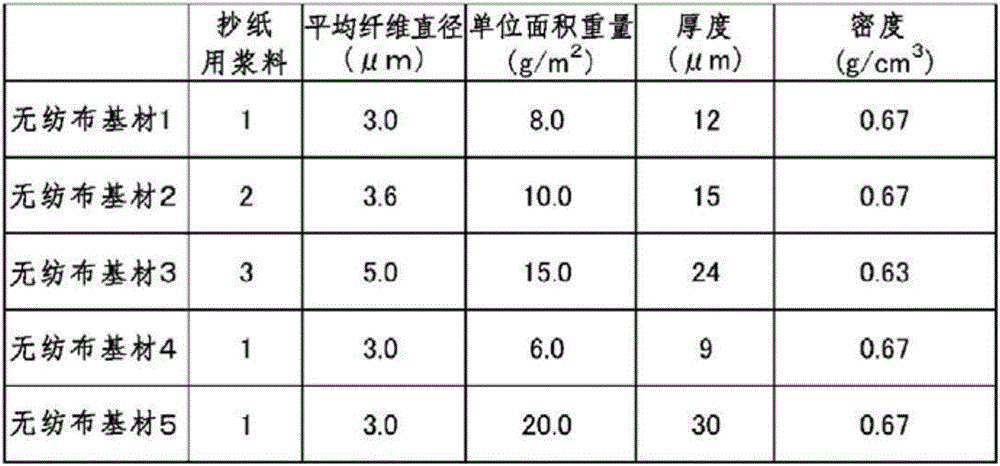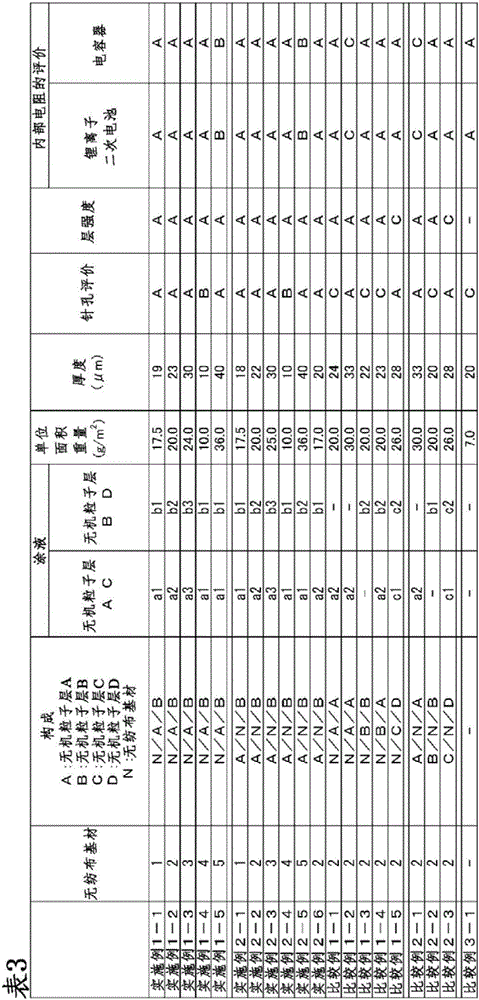Electrochemical element separator and electrochemical element obtained using same
A technology for electrochemical components and chemical components, applied in electrical components, electrochemical generators, electrolytic capacitors, etc., can solve problems such as easy occurrence of internal short circuit, loss of isolation between positive and negative electrodes, easy generation of pinholes, etc., and achieve easy sealing , It is not easy to produce defects, and the effect of suppressing pinholes
- Summary
- Abstract
- Description
- Claims
- Application Information
AI Technical Summary
Problems solved by technology
Method used
Image
Examples
Embodiment 1-1
[0109] On the non-woven fabric substrate 1, use a reverse kiss (kiss reverse) type gravure coater to make the coating amount (dry) 7.0g / m 2 After applying the coating liquid a1 by the method and drying it, use a reverse kiss type gravure coater on the same coating surface so that the coating amount (dry) reaches 2.5g / m 2 The coating solution b1 was applied and dried in the same way as above to obtain a separator for an electrochemical element.
Embodiment 1-2
[0111] On the non-woven fabric substrate 2, use a reverse kiss type gravure coater to make the coating amount (dry) 5.0g / m 2 After applying the coating liquid a2 in the same way and drying it, use a reverse kiss type gravure coater on the same coating surface to make the coating amount (dry) 5.0g / m 2 The coating solution b2 was applied and dried in the same way as above to obtain a separator for an electrochemical element.
Embodiment 1-3
[0113] On the non-woven fabric substrate 3, use a reverse kiss type gravure coater to make the coating amount (dry) 3.0g / m 2 After applying the coating liquid a3 by the method and drying it, use a reverse kiss type gravure coater on the same coating surface so that the coating amount (dry) reaches 6.0g / m 2 The coating liquid b3 was applied and dried in the manner described above to obtain a separator for electrochemical elements.
PUM
| Property | Measurement | Unit |
|---|---|---|
| diameter | aaaaa | aaaaa |
| particle size | aaaaa | aaaaa |
| particle size | aaaaa | aaaaa |
Abstract
Description
Claims
Application Information
 Login to View More
Login to View More - R&D
- Intellectual Property
- Life Sciences
- Materials
- Tech Scout
- Unparalleled Data Quality
- Higher Quality Content
- 60% Fewer Hallucinations
Browse by: Latest US Patents, China's latest patents, Technical Efficacy Thesaurus, Application Domain, Technology Topic, Popular Technical Reports.
© 2025 PatSnap. All rights reserved.Legal|Privacy policy|Modern Slavery Act Transparency Statement|Sitemap|About US| Contact US: help@patsnap.com


